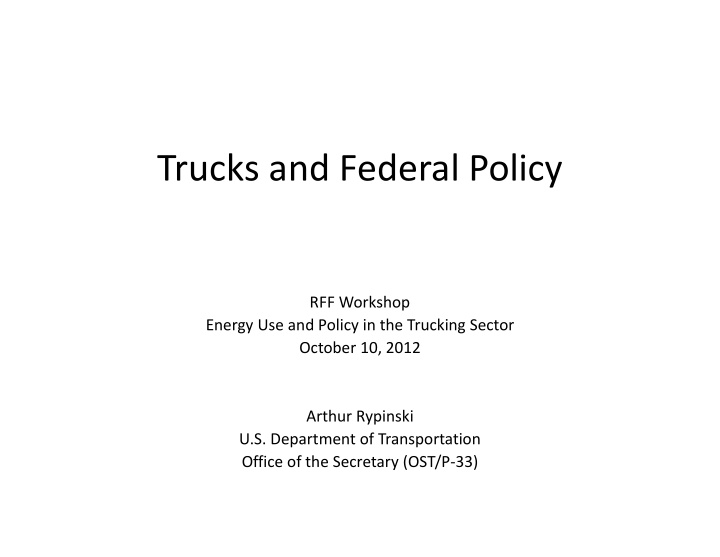



Trucks and Federal Policy RFF Workshop Energy Use and Policy in the Trucking Sector October 10, 2012 Arthur Rypinski U.S. Department of Transportation Office of the Secretary (OST/P-33)
Trucks are part of a freight system….
With multiple elements, diverse actors • Vehicles and infrastructure; • Capital goods suppliers; • Operators and customers; • Public and private; • Federal, State, and Local Governments; • Large firms and individual owner-operators; • Multiple forms of regulation.
U.S. Freight Shipments by Mode, 1980 - 2009 (Million Ton-Miles) 5,000,000 4,500,000 Total Shipments 4,000,000 3,500,000 Million Ton-Miles 3,000,000 2,500,000 2,000,000 Rail 1,500,000 Truck 1,000,000 Marine 500,000 Pipeline 0 1980 1982 1984 1986 1988 1990 1992 1994 1996 1998 2000 2002 2004 2006 2008 Source: USDOT/BTS, NTS Table 1-50
Freight ton-miles have grown more slowly than U.S. economy, truck ton-miles more rapidly… Annual Growth Rates in U.S. Modal Share of Freight Ton- Freight Ton-Miles by Mode, Miles, 2009 5% 1980-2009 Air 4% 0% Pipeline 21% 3% Truck 31% 2% 1% 0% Domestic Marine -1% 11% -2% Rail -3% 37% SOURCE: DOT/BTS, NTS, Table 1-50 -4% Source: DOT/BTS, NTS Table 1-50
The Role of Trucks • Trucks account for 71 percent of the value of freight shipments ($8.3 trillion) in 2007 (2007 CFS). • Trucks dominate some markets, compete in others, play minor or temporary role in yet others. – Intercity – Local delivery – “Vocational” – Bulk commodities • Dynamic and rapidly evolving economy favors trucks— stable economy favors optimization.
Trucks are premium transportation: fast, convenient, expensive, fuel intensive 100 Freight Revenue per Ton-Mile by Mode, Estimated National Average Freight 89.46 2007 Energy Consumption per Ton-Mile 90 (Cents per Ton-Mile ) by Mode, 2009 80 4,000 3,572 70 3,500 60 3,000 Btu Per Ton-Mile 50 2,500 40 2,000 30 1,500 1,000 16.54 20 500 289 10 217 2.99 1.83 1.61 0 0 Truck Rail Ship Air Truck Rail Barge Oil Source: DOT/BTS, NTS, Tables 2-7, 2-15. (2004) Pipeline Source: DOT/BTS, NTS, Table 3-21
Transportation Policy Issues Features of the New Transportation Bill • – National Freight Policy and Freight Corridors; – Performance Metrics for Highway Systems – Emphasis on “State of Good Repair” Long-Term Developments • – Evolution of domestic containerization; – Evolution of transportation customers (agriculture, energy, containers) – Infrastructure maintenance; – Infrastructure development; – Infrastructure financing methods; Hardy Perennials • – Truck size and weight limits – Double trailers – Truck idling; – Alternative fuels infrastructure
Thank-you for your attention! Questions?
Recommend
More recommend